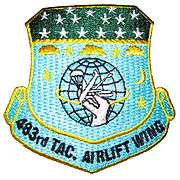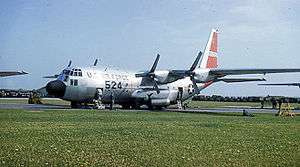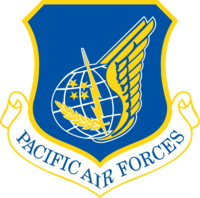483d Tactical Airlift Wing
| 483d Tactical Airlift Wing | |
|---|---|
|
thumbTong 725, a C-7A Caribouof the 535th Tactical Airlift Squadron, October 1971 | |
| Active | 1953–1960, 1966-1972 |
| Country |
|
| Branch |
|
| Role | Airlift |
| Part of | Pacific Air Forces |
| Motto(s) | Efficient Airlift Support |
| Engagements |
Korean Service Vietnam Service |
| Decorations |
Presidential Unit Citation Air Force Outstanding Unit Award Korean Presidential Unit Citation Gallantry Cross (Vietnam) |
| Insignia | |
| Patch with 483d Tactical Airlift Wing emblem (approved 2 Feb 1956)[1] |
 |
The 483d Tactical Airlift Wing was a tactical airlift and composite wing assigned to Pacific Air Forces during the Vietnam War. It was the host organization at Cam Ranh Bay Air Base South Vietnam from 1970–1972.
The unit history includes the temporarily bestowed history of the World War II 483d Bombardment Group, which was a United States Army Air Forces combat group. It served primarily in the Mediterranean, African, and The Middle East Theatres of World War II. During the Korean War, the group was redesignated the 483d Troop Carrier Groupand assigned to the wing.
The Wing was first organized as the 483d Troop Carrier Wing during the Korean War, as an airlift organization assigned to Far East Air Forces (later Pacific Air Forces) (PACAF) for duty.
History
Korean War
.jpg)

The wing was activated at Ashiya AB, Japan as the 483d Troop Carrier Wing on 1 January 1953 and replaced the 403d Troop Carrier Wing, Medium and absorbed the 403d's mission, personnel and equipment.[1] It was assigned to the 315th Air Division of Far East Air Forces (FEAF) for duty in the Korean War.
The wing was equipped with Fairchild C-119 Flying Boxcars and performed troop carrier and air transport operations in the Far East, including landing of troops and cargo in forward areas of the combat zone, air transportation of airborne troops and equipment, and air evacuation of casualties.[1] In June 1953, as the Korean war neared an armistice, all wing C-119s airlifted the entire 187th Regimental Combat Team (Airborne) from Kyushu, Japan to Seoul and Chunch'on, South Korea, to preclude enemy breakthroughs.[2] This was the largest mass movement of personnel in the history of combat cargo to that time.[1] For is actions in the Korean War, the wing received the Korean Presidential Unit Citation.
Between April 1953 and September 1954, the wing aided the French Air Force in Indochina by training aircrews, evacuating wounded, and maintaining aircraft.[1] For these actions, the wing became one of the first units in the Air Force to receive the Air Force Outstanding Unit Award. In 1958, the wing began to reequip with Lockheed C-130 Hercules aircraft.[3] Its transition was complete by 1959. It performed theater transport duties and participated in joint exercises with Army units[2] until inactivated in Japan on 23 June 1960. Its squadrons were transferred to the direct control of the 315th Air Division and relocated to Naha Air Base and Tachikawa Air Base, Japan as Ashiya AB closed.[4][5]
Vietnam War
The 483d Troop Carrier Wing (TCW) was again organized on 1 January 1967 at Cam Ranh Air Base, South Vietnam when the United States Army transferred all its C-7 Caribou aircraft to the Air Force.[1] The 483d TCW was assigned the mission of providing intra-theater airlift in support of United States military civic actions, combat support and civic assistance throughout the Republic of Vietnam.[6] In addition, the wing was transferred ex-United States Army C-7A Caribou light transports.[1]
The C-7s provided the light load-short haul transport to rough landing strips in South Vietnam. The unique capabilities of the C-7 for short landing and takeoff made Caribou transports vital to the war effort. On many occasions the C-7A's flew emergency airlift missions to airstrips and combat areas that no other aircraft could reach. Most notable were those in support of special forces camps in the Central Highlands.
In June 1968 the wing flew a record 2,420 combat troops in three days between Dak Pek, Ben Het and Đắk Tô. In August 1968 pinpoint night airdrops were accomplished at Duc Lap, Ha Thanh and Tonle Cham Special Forces camps. Ammunition and medical supplies were parachuted into 75-foot-square drop zones while the camps were under attack. In June 1969 during the siege of Ben Het more than 200 tons of ammunition, POL, rations, water and medical supplies were airdropped into a 100 x 200-foot zone with every load on target and 100 per cent recovered.
In March 1969, a provisional group was established at Vung Tau Airfield to exercise command and control over the wing's units located there.[7] As drawdowns from Viet Nam began, the group was discontinued in June 1970.[1]
In March 1970, when the 12th Tactical Fighter Wing was inactivated, the wing became the host wing at Cam Ranh Air Base. As a corrolary to assuming the support mission for the base, support organizations assigned to the wing carried out a number of civic actions, including construction of housing, providing support for orphanages and educational institutions and improvement of water supply systems.[8]
Again in April 1970, the wing, now designated the 483d Tactical Airlift Wing (TAW) helped break the siege of Dak Seang Special Forces Camp.[8] The wing flew 100 air-drop sorties under heavy hostile fire in ten days delivering some 400,000 pounds of vital supplies. When three C-7s were shot down with the loss of all crewmen between 2 and 6 April,[8] the operation switched to low-level night drops. On 15 May 1970 the 459th Tactical Airlift Squadron (TAS) ceased operations in preparation for inactivation 1 June as part of the U.S. forces drawdown in Vietnam, and on 31 August 1971 its sister unit at Phù Cát Air Base, the 537th TAS, inactivated in place, followed shortly thereafter by the 536th TAS at Vung Tau. During their five years' flying for the 483d TAW, the C-7A Caribous carried more than 4.7 million passengers, averaging more than one million a year during 1967–1969. At the same time the wing averaged more than 100,000 tons of cargo each year.
On 31 August 1971, three electronic warfare squadrons from the inactivating 460th Tactical Reconnaissance Wing, stationed at various bases in Viet Nam, were assigned to the 483d TAW. The following day, two special operations squadrons were transferred from the inactivating 14th Special Operations Wing. The electronic warfare squadrons were inactivated or assigned to other wings within six months.
The three remaining C-7 squadrons inactivated in early 1972 (535th TAS on 24 January, 458th on 1 March, and 457th on 30 April). Most of the C-7 Caribous were transferred to the VNAF. All Australian aircraft departed for Australia. The mixture of reassigned squadrons from other wings were all inactivated or reassoigned by the end of May. The 483d Tactical Airlift Wing was inactivated on 31 May 1972.[1] For its service in Vietnam, the 483d TAW was awarded two Presidential Unit Citations, three Air Force Outstanding Unit Awards with combat "V" (Valor) device and three Republic of Viet Nam Gallantry Crosses.
Lineage
483d Tactical Airlift Wing
- Constituted as 483d Troop Carrier Wing, Medium, on 15 November 1952[1]
- Redesignated 483d Troop Carrier Wing on 12 October 1966 and activated (not organized)[1]
- Organized on 15 October 1966[1]
- Redesignated 483d Tactical Airlift Wing on 1 August 1967[1]
- Inactivated on 31 May 1972.[1]
Assignments
- Tactical Air Command (Attached to 315th Air Division (Combat Cargo)), 1 January 1953 – 30 June 1954
- 315th Air Division (Combat Cargo), 1 July 1954 – 25 June 1960
- Pacific Air Forces, 12 October 1966 (not organized)
- 834th Air Division, 15 October 1966 (Not operational, 15 Oct 1966 - 3 Nov 1966)
- Seventh Air Force, 1 December 1971 – 31 May 1972[1]
Components
Groups
- 314th Troop Carrier Group, 1 Jan 1953 – 15 Nov 1954 (Attached)[9]
- 316th Troop Carrier Group, 15 Nov 1954 – 18 Jun 1957 (Attached—Not operational after 15 Mar 1956)[1]
- 483d Troop Carrier Group, 1 Jan 1953 - 8 December 1958 (Not operational after 15 Mar 1956)[1]
- 483d Air Base Group (later 483d Combat Support Group), 1 Jan 1953 - 25 Jun 1960, 31 Mar 1970 - 31 May 1972[10]
- 483d Maintenance & Supply Group, 1 Jan 1953 - 8 December 1958 (Not operational after 15 Mar 1956)
- 483d Medical Group (later 483d Tactical Hospital, 483d USAF Hospital), 1 Jan 1953 - 25 Jun 1960, 31 Mar 1970 - 31 May 1972[11][12]
- Tactical Group, Provisional, 6483d, 15 Mar 1969 – 30 Jun 1970[1]
- Located at Vung Tau Airfield, Viet Nam[8]
Operational Squadrons
Korean War
- 21st Troop Carrier Squadron: attached 1 Jul 1957 – 7 Dec 1958, assigned 8 Dec 1958 – 25 Jun 1960[13]
- 36th Troop Carrier Squadron: attached 15 Mar 1956 – 18 Jun 1957[14]
- 37th Troop Carrier Squadron: attached 15 Mar 1956 – 18 Jun 1957[15]
- 75th Troop Carrier Squadron: attached 15 Mar 1956 – 18 Jun 1957[1]
- 773d Troop Carrier Squadron: attached ca, 30 Aug 1958 - 10 Dec 1958.[1]
- 815th Troop Carrier Squadron: attached 15 March 1956-8 Dec 1958, assigned 8 Dec 1958-25 Jun 1960[4]
- 816th Troop Carrier Squadron: attached 15 March 1956-8 Dec 1958, assigned 8 Dec 1958-25 Jun 1960[16]
- 817th Troop Carrier Squadron: attached 15 March 1956-8 Dec 1958, assigned 8 Dec 1958-25 Jun 1960[5]
- 6461st Troop Carrier Squadron (later Air Transport Squadron): 1 Jan 1953 – 24 Jun 1955 (Attached)[1]
Vietnam War
- 20th Special Operations Squadron: 1 Sep 1971 – 1 Apr 1972[17] (UH-1)
- 90th Special Operations Squadron: 1 Sep 1971 – 15 Apr 1972[18] (A-37B Tail Code: CG)
- Stationed at Nha Trang Air Base, Viet Nam
- 360th Tactical Electronic Warfare Squadron: 31 Aug 1971 – 1 Feb 1972 (EC-47N/P/Q Tail Code: AJ)[1]
- Stationed at Tan Son Nhut Airport, Viet Nam
- 361st Tactical Electronic Warfare Squadron: 31 Aug 1971 – 1 Dec 1971 (EC-47N/P/Q Tail Code: AL)[1]
- Stationed at Phu Cat Air Base, Viet Nam
- 362d Tactical Electronic Warfare Squadron: 31 Aug 1971 – 1 Feb 1972 (EC-47N/P/Q C-47H Tail Code: AN)[1]
- Stationed at Pleiku Air Base, Viet Nam
- 457th Troop Carrier (later Tactical Airlift) Squadron: 1 Jan 1967 – 30 Apr 1972[1] (C-7A Tail Code: KA; call sign Cuddy)
- 458th Troop Carrier (later Tactical Airlift) Squadron: 1 Jan 1967 – 1 Mar 1972[19] (C-7A Tail Code: KC; call sign Law)
- 459th Troop Carrier (later Tactical Airlift) Squadron: 1 Jan 1967 – 1 Mar 1972[20] (C-7A Tail Code: KE; call sign Ellis)
- Stationed at Phu Cat Air Base, Viet Nam
- 535th Troop Carrier (later Tactical Airlift) Squadron: 1 Jan 1967 – 24 Jan 1972[21] (C-7A Tail Code: KH; call sign Tong) (detached to Tactical Group, Provisional, 6483d, 15 Mar 1969 – 30 Jun 1970)
- Stationed at Vung Tau Airfield 1 Jan 1967 - 21 Jun 1970
- 536th Troop Carrier (later Tactical Airlift) Squadron: 1 Jan 1967 – 15 Oct 1971[1] (C-7A Tail Code: KL; call sign Iris) (detached to Tactical Group, Provisional, 6483d, 15 Mar 1969 – 30 Jun 1970)
- Stationed at Vung Tau Airfield 1 Jan 1967 - ca 1 Jul 1970
- 537th Troop Carrier (later Tactical Airlift) Squadron: 1 Jan 1967 – 31 Aug 1971[22](C-7A Tail Code: KN; Soul)
- Stationed at Phu Cat Air Base, Viet Nam
- Royal Australian Air Force, Transport Flight Vietnam / 35 Squadron (DHC-4 call sign: Wallaby) Jul 1964 - Feb 1972
- Stationed at Vung Tau Airfield, Viet Nam
Support Units
- 6466th USAF Hospital: ca. 1 Jul 1954 - 25 Jun 1960[23]
- 483d Avionics Maintenance Squadron (later 483d Consolidated Aircraft Maintenance Squadron, 483d Field Maintenance Squadron): 8 Mar 1958 - 25 Jun 1960, 15 Jul 71 - 30 Apr 1972[10]
- 483d Field Maintenance Squadron (later 483d Consolidated Aircraft Maintenance Squadron, 483d Field Maintenance Squadron): 8 Mar 1958 - 25 Jun 1960, 1 Jan 1967 - 13 May 1972[10]
- 483d Flight Line Maintenance Squadron: 8 Mar 1958 - 18 Dec 1959[23]
- 483d Periodic Maintenance Squadron (later 483d Organizational Maintenance Squadron): 8 Mar 1958 - 25 Jun 1960, 10 Dec 1970 - 30 Apr 1972[10]
- 483d Munitions Maintenance Squadron, 15 Jul 1971 - 30 Apr 1972[10]
- 6483d Flight Line Maintenance Squadron: 22 Aug 1957 - 8 Mar 1958[24]
- 6483d Periodic Maintenance Squadron: 22 Aug 1957 - 8 Mar 1958
Stations
- Ashiya AB, Japan, 1 January 1953 – 25 June 1960.
- Cam Ranh Bay AB, South Vietnam, 15 October 1966 – 31 May 1972.
Aircraft flown
|
|
|
|
Awards
The temporary bestowal of the honors of the 483d Bombardment Group entitles the wing to display the two Distinguished Unit Citations earned by the group as appropriate in addition to these awards.
-
- Presidential Unit Citation
-

- Air Force Outstanding Unit Award with "V" Device
-

- Air Force Outstanding Unit Award
- 6 May 1953 - 10 Sep 1954[25]
-
- Korean Presidential Unit Citation
- 1 Jan 1953 - 27 Jul 1953[25]
-

- Republic of Viet Nam Gallantry Cross
-

- Korean Service Medal
- Campaigns[25]
- Third Korean Winter
- Korea Summer-Fall 1953
-
- Viet Nam Service Medal
- Campaigns[1]
|
|
|
References
Notes
- 1 2 3 4 5 6 7 8 9 10 11 12 13 14 15 16 17 18 19 20 21 22 23 24 25 26 27 28 29 Ravenstein, Charles A. (1984). Air Force Combat Wings, Lineage & Honors Histories 1947-1977 (PDF). Washington, DC: Office of Air Force History. pp. 268–270. ISBN 0-912799-12-9.
- 1 2 Abstract, History 483d Troop Carrier Wing, Jan-Jun 1953 (accessed Oct 28, 2012)
- ↑ Abstract, History of 483d Troop Carrier Wing Jan-Jun 1958 (accessed Oct 28, 2012)
- 1 2 AFHRA Factsheet, 815th Airlift Squadron (accessed Oct 27, 2012)
- 1 2 AFHRA Factsheet, 817th Expeditionary Airlift Squadron (accessed Oct 27, 2012)
- ↑ Abstract, History 483d Troop Carrier Wing Jan-Jun 1967 (accessed Oct 28, 2012)
- ↑ Abstract, History of 483d Tac Airlift Wing, Oct-Dec 1969 (accessed Oct 28, 2012)
- 1 2 3 4 Abstract, History of 483d Tac Airlift Wing, Apr-Jun 1970 (accessed Oct 28, 2012)
- ↑ AFHRA Factsheet, 314th Operations Group (accessed Oct 27, 2012)
- 1 2 3 4 5 Abstract, 483 Tac Airlift Wing Subordinate Unit Histories Oct-Dec 1971 (accessed Oct 28, 2012)
- ↑ See Abstract, History of 403d Medical Group Dec 1952 (accessed Oct 28, 2012)
- ↑ Abstract, History of 483d USAF Hospital Jul 1971-May 1972 (accessed Oct 28, 2012) History notes that Hospital became the drug abuse detoxification center for all AF personnel in Viet Nam
- ↑ AFHRA Factsheet, 21st Airlift Squadron (accessed Oct 26, 2012)
- ↑ AFHRA Factsheet, 36th Airlift Squadron (accessed Oct 27, 2012)
- ↑ AFHRA Factsheet, 37th Airlift Squadron (accessed Oct 27, 2012)
- ↑ Maurer, Maurer, ed. (1982) [1969]. Combat Squadrons of the Air Force, World War II (PDF) (reprint ed.). Washington, DC: Office of Air Force History. pp. 766–767. ISBN 0-405-12194-6.
- ↑ AFHRA Factsheet, 20th Special Operations Squadron (accessed Oct 27, 2012)
- ↑ AFHRA Factsheet, 90th Fighter Squadron (accessed Oct 27, 2012)
- ↑ AFHRA Factsheet 458th Airlift Squadron (accessed Oct 26, 2012)
- ↑ AFHRA Factsheet 459th Airlift Squadron (accessed Oct 26, 2012)
- ↑ AFHRA Factsheet 535th Airlift Squadron (accessed Oct 26, 2012)
- ↑ AFHRA Factsheet 537th Airlift Squadron (accessed Oct 26, 2012)
- 1 2 Abstract, History 483d Troop Carrier Wing Jul-Dec 1959 (accessed Oct 28, 2012)
- ↑ Abstract, History of 483d Troop Carrier Wing, Aug-Dec 1957 (accessed Oct 28, 2012)
- 1 2 3 4 5 6 AF Pamphlet 900-2, Unit Decorations, Awards and Campaign Participation Credits Department of the Air Force, Washington, DC, 15 Jun 71, p. 403
- 1 2 3 4 5 AF Pamphlet 900-2, Unit Decorations, Awards and Campaign Participation Credits, Vol II Department of the Air Force, Washington, DC, 30 Sep 76 , p. 76
Bibliography
![]() This article incorporates public domain material from the Air Force Historical Research Agency website http://www.afhra.af.mil/.
This article incorporates public domain material from the Air Force Historical Research Agency website http://www.afhra.af.mil/.
- Maurer, Maurer, ed. (1982) [1969]. Combat Squadrons of the Air Force, World War II (PDF) (reprint ed.). Washington, DC: Office of Air Force History. ISBN 0-405-12194-6.
- Ravenstein, Charles A. Air Force Combat Wings, Lineage & Honors Histories 1947-1977 (PDF). Washington, DC: Office of Air Force History. ISBN 0-912799-12-9.
- AF Pamphlet 900-2, Unit Decorations, Awards and Campaign Participation Credits Department of the Air Force, Washington, DC, 15 Jun 71
- AF Pamphlet 900-2, Unit Decorations, Awards and Campaign Participation Credits, Vol II Department of the Air Force, Washington, DC, 30 Sep 76
Further Reading
- Endicott, Judy G., ed. (2001). The USAF in Korea, Campaigns, Units and Stations 1950-1953 (PDF). Maxwell AFB, AL: Air Force Historical Research Agency. ISBN 0-16-050901-7.
- Futrell, Robert F. (1983). The United States Air Forces in Korea 1950-1953. Washington, DC: Office of Air Force History. ISBN 0-912799-71-4.
- Maurer, Maurer, ed. (1983) [1961]. Air Force Combat Units of World War II (PDF) (reprint ed.). Washington, DC: Office of Air Force History. ISBN 0-912799-02-1. LCCN 61060979.
- Nalty, Bernard C. (1986). Air Power and the Fight for Khe Sanh (PDF). Washington, DC: Office of Air Force History. ISBN 978-1410222589. Retrieved July 7, 2015.





.svg.png)